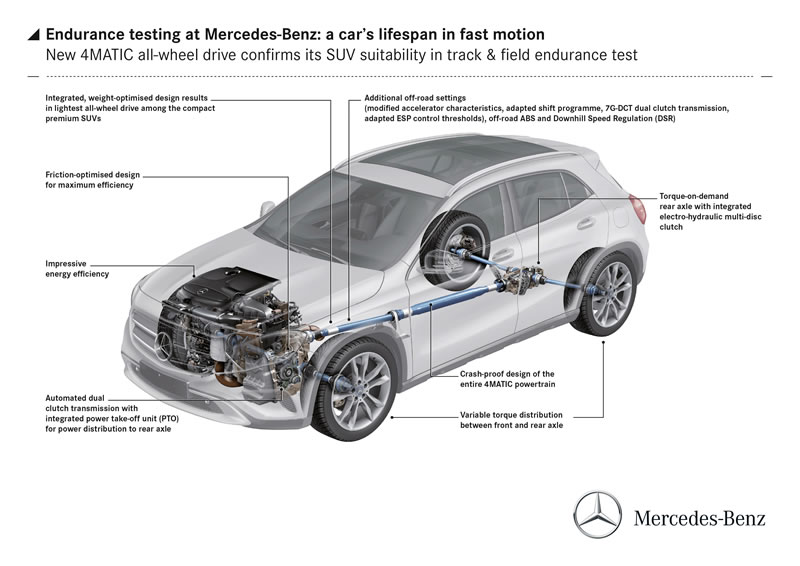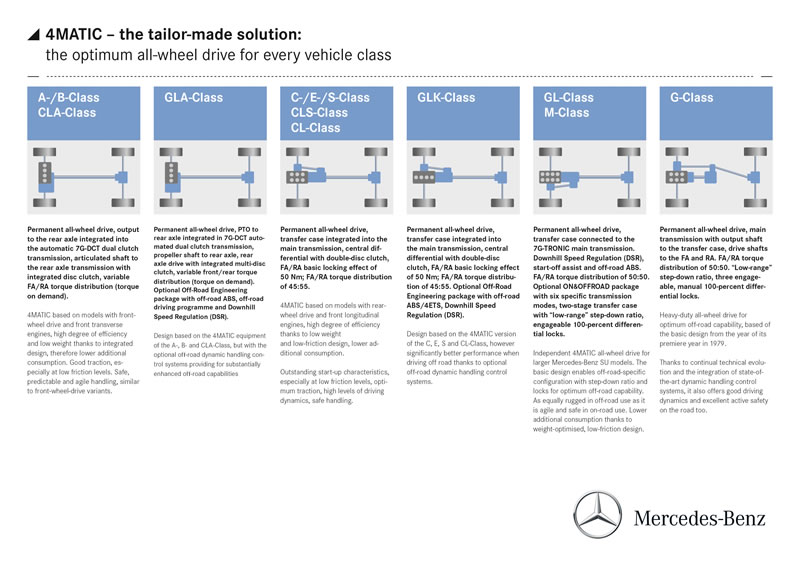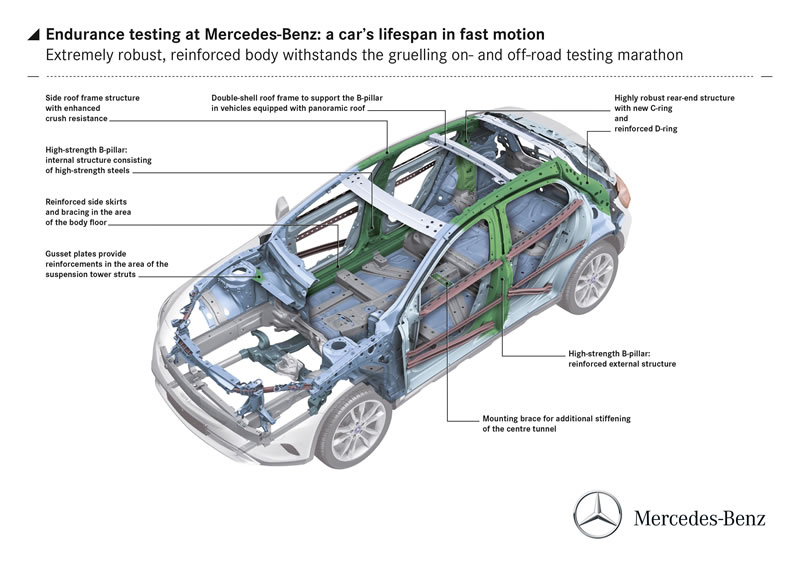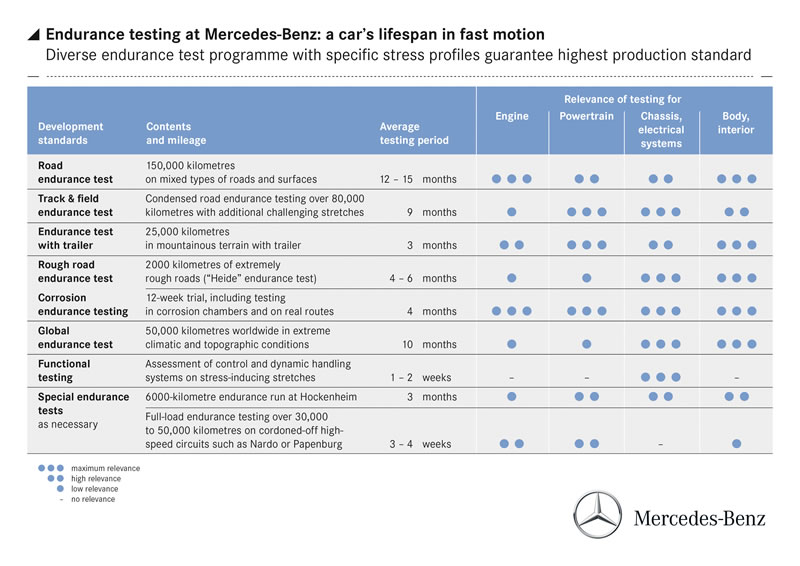The new GLA-Class has successfully completed an endurance trial which, in addition to on-road testing, also takes in the stresses and strains typical of off-road all-wheel drive use. In the course of this track & field endurance trial extending over some nine months, a vehicle’s entire subsequent lifespan in the customer’s hands is simulated at time-lapse speed to verify the GLA’s fitness for series production.

GLA-Class 4MATIC
Like the undisputedly robust GLK-Class before it, the GLA-Class has also mastered a special endurance trial in the form of the track & field endurance test. Covering some 80,000 kilometres, this test is based on the “standard” road endurance tests and is supplemented by a number of special sections far off paved roads, a sprint programme at the Nürburgring Nordschleife and intensive trials in an Alpine environment. Following on from the GLA and GLK, the track & field endurance test extending over around nine months is set to remain the acid test for all vehicles belonging to the Mercedes-Benz small and compact SUV range.
Simulating the entire lifespan of a vehicle within nine months requires a defined load scenario which the test engineers realise with different “load collectives”. The track & field endurance test includes extensive drives on country roads, motorways or in inner-city stop-and-go traffic – disciplines familiar from the conventional road endurance testing programme covering 150,000 kilometres.
The track & field endurance test rounds off the extensive endurance testing programme carried out worldwide by Mercedes-Benz. This endurance testing programme differs fundamentally from the development and tuning runs performed on new models; these are done additionally. Whereas on these runs the characteristics laid down in the specifications book are verified, programmes like the track & field endurance test verify the reliability and durability of new models, thus ensuring their fitness for series production.

Endurance Testing at Mercedes-Benz
Aggravated conditions: Nürburgring, Alps, tank practice grounds
The notorious endurance runs on the world’s toughest race track – the Nürburgring Nordschleife – are well known. A one-kilometre sprint is equivalent to 20 kilometres in the real life of an automobile. And the GLA has to complete 240 laps or around 6000 kilometres here. This means the time spent at the Nürburgring adds up to the equivalent of 100,000 “real” kilometres. The endurance tests in an Alpine environment are similarly demanding. One stretch in the Italian Alps is a veritable helter-skelter ride, with one stage of the test along a distance of 154 kilometres taking in 9 Alpine passes and 450 bends. A difference in elevation of 4300 metres also has to be overcome, and the overall test distance on this track after 20 laps totals 3080 kilometres. The numerous winding bends impose a particular strain on both the chassis and the 4MATIC drivetrain as the vehicle accelerates out of the bends, and ensure that the dynamic handling control systems have their work cut out.
In view of its lineage, Mercedes-Benz requires the new compact SUV to prove its mettle off the beaten track too. After all, in deference to the G-Class – the grandfather of all SUVs and cross-country vehicles with the star – only those vehicles that also meet certain minimum requirements off-road may carry a “G” in their name. To ensure this, the track & field endurance test includes a run that very freely construes the term “primitive road” – the so-called tank ring road of a military training area of the German Armed Forces in southern Germany. Where giant chain-driven 62-tonne vehicles rated at 1103 kW (1500 hp) are normally to be found making their way to the various training areas, churning up the unpaved ground below them as they go, the GLA is required to demonstrate over 1000 kilometres that it is able to stand up to such adverse conditions on a sustained basis.

GLA Testing – World map
Grand finale with complete dismantling and detailed assessment
Before the various professional journals set about examining the solidity and reliability of the SUVs from Mercedes-Benz in endurance tests which generally cover over 100,000 kilometres, the test engineers had already performed this task a couple of dozen times – including complete dismantling. In all, 24 different GLA models completed the track & field endurance test and other endurance runs, clocking up some 1.8 million kilometres in the process. After the completed track & field endurance testing, all the GLA marathon runners were disassembled and their individual components were spread out like an automotive puzzle. Behind closed doors, the development and test engineers of the specialist departments subsequently evaluated all the vehicle components with reference to the test results, defining measures for optimising components as necessary.
Sound basis for maximum stability
The outstanding results of the endurance tests place the merits of the GLA’s chassis and body beyond doubt and confirm that this solid basis is built to last a vehicle’s lifetime in operation by the customer, even in the toughest service conditions. The GLA has an extremely rigid body, providing the basis for stable and safe handling characteristics both on and off the road, as well as best-in-class NVH comfort and outstanding passive safety. Weighing in at 400.3 kilograms, 73 percent of the bodyshell is comprised of high-strength and ultra-high-strength steels. In the area of the side roof frame and the new C-ring structure in the rear, hot-formed steels are used – ensuring the highest strength category possible for body steels.
The outstanding stability of the GLA’s body-in-white will also be highlighted by the Mercedes-Benz GLA 45 AMG which is to be launched in due course. This high-power SUV with a 2.0-litre turbo engine offers an output of 265 kW (360 hp), maximum torque of 450 Newton metres and does not require any reinforcement of its body, despite its vast power.

GLA-Class 4MATIC
All set for any operating conditions: 4MATIC and 7G-DCT
The new 4MATIC from Mercedes-Benz is featuring for the first time in an SUV. This permanent all-wheel drive with fully variable torque distribution is tailor-made for the compact GLA SUV, as the off-road variant of the new 4MATIC all-wheel drive based on the front-wheel-drive architecture formed an integral part of the system development process. The engineers accorded due consideration to deployment in off-road vehicles right from the earliest phases of development. Both on and off-road, the new 4MATIC harmonises outstandingly with the 7G-DCT automated dual clutch transmission.
Vehicles with 4MATIC feature additional off-road control functions and the corresponding presentation of off-road-related data on the CENTRAL MEDIA DISPLAY. In off-road transmission mode, the transmission shift points, accelerator pedal characteristics and thresholds of the dynamic handling control systems are adapted accordingly, resulting in substantially enhanced off-road capabilities. An off-road comfort suspension (front +30 millimetres, rear +22 millimetres) further broadens the scope of equipment on offer. DSR (Downhill Speed Regulation) is activated via a control button in the centre console to assist the driver on steep and demanding downhill stretches.






